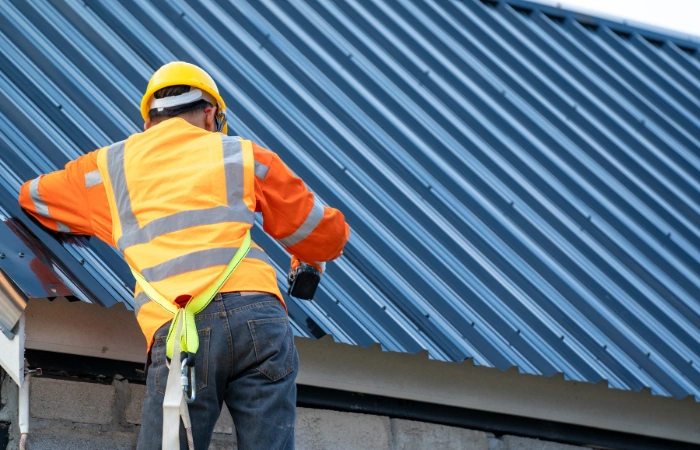Roof leaks in Tomball, TX, are more than an inconvenience—they can lead to significant damage if not addressed quickly. A small leak can result in water damage to your home’s interior, mold growth, and even structural issues. Spotting and fixing roof leaks promptly is essential for maintaining your home’s integrity. We will explore how to identify common signs of roof leaks and provide practical steps for fixing them before they escalate into larger problems.
Common signs of roof leaks
- Identifying the Source of the Leak: Tracing the Problem
One of the most challenging aspects of dealing with roof leaks is pinpointing the exact source of the problem. Water can travel along beams and walls before dripping into your home, making it difficult to find the origin. Start by looking for water stains on ceilings or walls, often the first visible signs of a leak. These stains may appear as discolored patches, usually yellow or brown, and could grow over time if the leak persists.
In many cases, the leak may not be directly above the stain. To track down the source, inspect your attic for signs of water entry, such as wet insulation or puddles. Follow the water trail to the point where it enters the home. We will explore how locating the source of the leak is the first critical step in repairing the damage and preventing further issues.
- Checking Common Problem Areas: Roof Features and Components
Certain areas of your roof are more prone to leaks than others. Start by inspecting roof features such as flashing, vents, chimneys, and skylights. Flashing is the metal material used to seal the edges of roof features, and if it becomes loose or damaged, it can allow water to seep through. Check around chimneys, where flashing can deteriorate over time due to exposure to the elements.
Another common cause of leaks is missing, cracked, or damaged shingles or tiles. High winds, heavy rain, or aging can cause shingles to wear out or break, exposing the underlayment to moisture. Additionally, clogged gutters can prevent water from draining properly, causing it to pool on the roof and seep into weak spots. We will explore how checking these common problem areas can help you quickly identify where leaks are occurring and address the root cause.
- Temporary Fixes: Stopping the Leak Immediately
Once you’ve identified the source of the leak, it’s essential to take immediate action to prevent further damage, even if you can’t make permanent repairs immediately. Temporary fixes can help stop the leak until you can complete a more thorough repair. One effective solution is roofing tape or sealant to cover gaps, holes, or damaged flashing. This can create a waterproof barrier that will stop water from entering.
If the leak comes from damaged shingles, apply a temporary patch using roofing cement or tar. Press the damaged shingle back into place and cover the area with the roofing compound to create a seal. While these fixes are not permanent, they can provide enough protection to prevent further water damage until you can repair more comprehensively. We will explore how these temporary solutions quickly address roof leaks while planning for a longer-lasting fix.
- Making Permanent Repairs: Fixing the Leak Properly
Once you’ve taken temporary measures to stop the leak, it’s important to make permanent repairs to ensure the problem doesn’t return. For damaged shingles, consider replacing them with new ones to restore the roof’s integrity. Remove the broken or missing shingles and carefully install the new ones, ensuring they are securely fastened to prevent future leaks.
If the leak is caused by faulty flashing around chimneys, vents, or skylights, you may need to replace the flashing entirely. Seal any gaps with roofing cement or a high-quality waterproof sealant. It’s also a good idea to inspect the entire roof for additional weak spots while making repairs to prevent new leaks from forming. We will explore how thorough, long-term repairs ensure that your roof remains leak-free and protects your home from future water damage.
- Preventive Measures: Maintaining Your Roof
Preventing roof leaks in the future is just as important as fixing the ones you currently have. Regular roof maintenance can help you catch potential issues before they become full-blown leaks. Start by inspecting your roof at least twice yearly, looking for signs of damage, wear, or aging. Clear any debris from the roof, especially in areas where leaves, twigs, and dirt can accumulate and trap moisture.
Maintaining your gutters is another key step in preventing leaks. Clean gutters allow water to flow freely off the roof and away from your home. Clogged gutters, on the other hand, can cause water to back up onto the roof, increasing the risk of leaks. We will explore how regular maintenance and inspections can help prevent roof leaks and extend the life of your roof.
Protecting Your Home from Water Damage
Roof leaks can lead to extensive damage if left unchecked, but with timely detection and proper repairs, you can protect your home from costly issues. From identifying the source of the leak to making temporary fixes and permanent repairs, taking the right steps is crucial for maintaining your roof’s integrity. We will explore how spotting roof leaks early and addressing them effectively can prevent water damage, preserve the structure of your home, and give you peace of mind knowing your roof is secure. By incorporating preventive measures into your routine, you can keep your roof in top condition and avoid future leaks.

